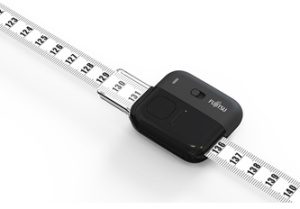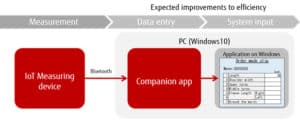Tired of ill-fitting mass-produced garments, a growing number of consumers today have turned back the clock to demand clothes made to cater to their unique body size and shapes. Custom-made apparels are making a comeback in a big way and retailers are struggling to keep up with the trend.

Aware that mistakes in writing or in reading vouchers for alterations of ready and custom-made garments are a frequent occurrence, Fujitsu created a new IoT measuring device that promises to dramatically improve the efficiency of apparel sizing and measurements.
The new device, the prototype of which was created through crowdfunding, will be offered with a companion app for recording information about measurements taken with the device.
“The prototype has generated interest in a variety of industries,” said Fujitsu in a statement. “We have received inquiries not only from the apparel industry but also from possible customers in transportation and manufacturing.”
How the device work
By pressing a special button in the device, the measurement data is transferred to the cursor position of the Windows application (such as Excel or Notepad) on the Bluetooth-paired PC through the dedicated companion app. This will enable the automatic input of values each time the measurement button is pressed, instead of manually transferring data to a recording sheet or slip, accelerating work efficiency and reducing errors in posting.

By reading the special pattern printed on the back of the tape, measurements can be made in units of one millimetre. Since it isn't necessary to rewind the measure tape when continuously measuring multiple points, users can perform measurements quickly and easily.
This makes it possible not only to improve the overall efficiency in the apparel industry, including for important tasks like measurement and inspecting goods, but may offer future potential uses in the transportation industry and the manufacturing industries.
Fujitsu is targeting to sell 30,000 units of the device by the end of its fiscal year 2022, which end on March 31. The company plans deliver support for smartphone applications on iOS and Android in the future.



